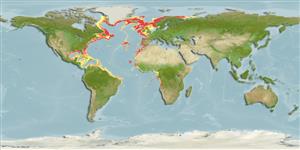Actinopterygii (ray-finned fishes) >
Aulopiformes (Grinners) >
Notosudidae (Waryfishes)
Etymology: Scopelosaurus: Greek, skopelos = a lantern fish + Greek, sauros = lizard (Ref. 45335).
Environment / Climate / Range
Ecology
Marine; benthopelagic; oceanodromous (Ref. 51243); depth range 70 - 1404 m (Ref. 58426). Deep-water, preferred ?; 71°N - 15°S
North Atlantic: subarctic region to the subtropical latitudes.
Size / Weight / Age
Maturity: Lm ? range ? - ? cm
Max length : 36.4 cm SL male/unsexed; (Ref. 6552); common length : 35.0 cm SL male/unsexed; (Ref. 6552)
Adults found between 500-800 m depth while the oceanic young stages between 70-200 m (Ref. 6689). Bathypelagic (Ref. 58426). The young feeds mainly on copepods while the large ones on euphausiids, hyperiids and mesopelagic fishes. Adults undertake far-ranging feeding migrations (outside the spawning season) to the slope areas of Europe, North America and West Africa. Spawning probably occurs in midwater far offshore, with a concentration in the Sargasso Sea (Ref. 6689).
Life cycle and mating behavior
Maturity | Reproduction | Spawning | Eggs | Fecundity | Larvae
Krefft, G., 1990. Notosudidae. p. 361-364. In J.C. Quero, J.C. Hureau, C. Karrer, A. Post and L. Saldanha (eds.) Check-list of the fishes of the eastern tropical Atlantic (CLOFETA). JNICT, Lisbon; SEI, Paris; and UNESCO, Paris. Vol. 1. (Ref. 6552)
IUCN Red List Status (Ref. 115185)
CITES (Ref. 94142)
Not Evaluated
Threat to humans
Harmless
Human uses
More information
Common namesSynonymsMetabolismPredatorsEcotoxicologyReproductionMaturitySpawningFecundityEggsEgg development
ReferencesAquacultureAquaculture profileStrainsGeneticsAllele frequenciesHeritabilityDiseasesProcessingMass conversion
Tools
Special reports
Download XML
Internet sources
Estimates of some properties based on models
Phylogenetic diversity index (Ref.
82805): PD
50 = 0.5001 [Uniqueness, from 0.5 = low to 2.0 = high].
Bayesian length-weight: a=0.00288 (0.00119 - 0.00698), b=3.18 (2.97 - 3.39), in cm Total Length, based on LWR estimates for this (Sub)family-body shape (Ref.
93245).
Trophic Level (Ref.
69278): 3.3 ±0.38 se; Based on food items.
Resilience (Ref.
69278): .
Vulnerability (Ref.
59153): Low to moderate vulnerability (34 of 100) .
